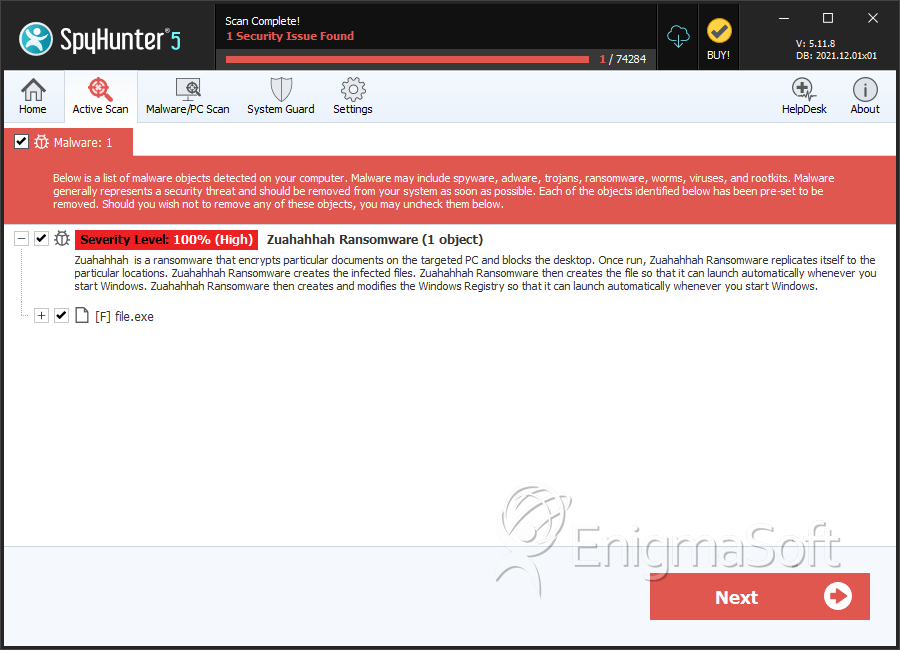Zuahahhah Ransomware
The Zuahahhah Ransomware is a ransomware Trojan that is used to encrypt the victims' files to demand a ransom payment. Malware researchers first received reports of the Zuahahhah Ransomware infections on July 28, 2017. Malware analysts classify the Zuahahhah Ransomware as an encryption ransomware Trojan because of the strategy used to extort computer users. Threats like these use strong encryption algorithms to make the victims' files inaccessible and demand ransom payments through Bitcoin to preserve their anonymity. Malware researchers have observed previous variants of the Zuahahhah Ransomware, with names such as the Crypt888 Ransomware (also known as the Aviso Ransomware). The most common way in which the Zuahahhah Ransomware is delivered to victims is by attaching it to spam email messages. The file attachment may take the form of a Microsoft Word file with enabled macros, which download and install the Zuahahhah Ransomware on the victim's computer.
Table of Contents
The Zuahahhah Ransomware Infection Process
When the Zuahahhah Ransomware infects a computer, the Zuahahhah Ransomware will communicate with its Command and Control server to send information about the infected computer to the people operating the Zuahahhah Ransomware. The Zuahahhah Ransomware will run the executable file 'server.exe' on the infected computer. During its attack, the Zuahahhah Ransomware will change the infected computer's Desktop image to deliver its ransom note. Using a mixture of the AES and RSA encryptions, the Zuahahhah Ransomware will encrypt the victim's files and then encrypt the encryption key itself, which means that the victim will not be able to recover the decryption key necessary to restore the affected files without paying a ransom. This is a typical encryption method used by these threats.
How the Zuahahhah Ransomware Takes the Victim’s Files Hostage
In its encryption process, the Zuahahhah Ransomware will take over the victim's computer, targeting the user-generated files, which may include photos, videos, music, databases, text files, spreadsheets, and numerous file types that are commonly associated with popular applications such as Microsoft Office, Libre Office and Adobe Photoshop. After encrypting the victim's files, the Zuahahhah Ransomware will present a ransom note. To do this, the Zuahahhah Ransomware changes the infected computer's Desktop image, which will contain a text message, which threatens the victim with a poorly worded ransom note. The following is the text presented in the Zuahahhah Ransomware Desktop wallpaper image:
'YOUR FILES HAS BEEN LOCKED
ZUAHAHHAH
Your Computer has been Get:
- password your account
- email account
- files your computer
- delete your files'
The Zuahahhah Ransomware seems to target both Portuguese and English speakers and carries out an effective and typical version of this popular tactic. Computer users should avoid paying any ransom associated with these attacks since it is very unlikely that paying a ransom will help restore the files compromised in the Zuahahhah Ransomware infection process.
Dealing with the Zuahahhah Ransomware Infection
If your computer has been infected with an encryption ransomware Trojan like the Zuahahhah Ransomware, paying the ransom is not a good idea. There are several reasons why paying the ransom is not the best solution when dealing with these infections:
- Con artists like those associated with the Zuahahhah Ransomware may not respond to the ransom payment and keep their promise to provide the decryption key. It is just as likely that they will ignore the payment, deliver a non-functional key or ask for more money.
- Paying the Zuahahhah Ransomware ransom allows the people responsible for this attack to continue creating and developing similar ransomware threats, targeting further victims.
- It is common for people that pay these ransoms to be targeted for future ransomware and threat tactics since it has been demonstrated that they are willing to pay the ransom.
The best solution to these threat infections is to use file backups to restore affected files and a reliable, fully updated anti-malware application to remove the Zuahahhah Ransomware infection itself.
SpyHunter Detects & Remove Zuahahhah Ransomware

File System Details
| # | File Name | MD5 |
Detections
Detections: The number of confirmed and suspected cases of a particular threat detected on
infected computers as reported by SpyHunter.
|
|---|---|---|---|
| 1. | file.exe | dd1a929dccd38a2e2d1b109188c3e1bf | 0 |

